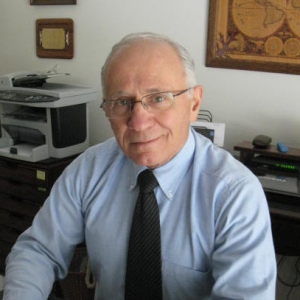When Jesus told Peter, “I will build my church,” did He have in mind a more perfect religion, one to rival existing religions in the world, or did He have in mind something of a higher spiritual nature? Distinction must clearly be made between religion and Christianity, as well as between the Old Covenant (Testament) in Moses and the New Covenant in Christ. The concept of life must be looked at from a spiritual perspective.
Mt. 16.18 “And I also say to you that you are Peter, and on this rock I will build My church, and the gates of Hades shall not prevail against it.”
Introductory Definitions
I will build—When Jesus said “I will build My church,” He did not have in mind anything of a physical church with buildings, cathedrals, a priesthood or separated clergy, or an organization with offices and duties. He told Pilate at His judgment hearing that His Kingdom was not of this world. His kingdom exists in power and reality, but not the reality of this world. Logic and reasoning cannot comprehend His Kingdom. Jesus’ Kingdom is spiritual, meaning it is invisible and intangible; it is composed of a body of believers in various ministries, of men and women of Godly character. So, His intent is to build a house, which simply meaning is a dwelling place; and since it is a spiritual house, it implies a non-physical dwelling place for God.
My Church—meaning the whole body of believers. The word in the Greek is ekklēsía (from /ek, “out from and to” and /kaléō, “to call”). And so it properly means a people called out from the world, and unto God—the results being the Church, the mystical body of Christ, the total body of believers whom God calls “out from” the world and “into” His eternal Kingdom.
And so, these definitions imply that the central mission of Christ was to redeem a people out from the world of darkness, sin and death, and to call them into the Kingdom of God, an eternal kingdom of light, righteousness, and life; in which God’s presence may be found. This was achieved in His crucifixion on the cross and His resurrection from the dead. The church was born in an upper room in Jerusalem when some 50 days after His ascension into heaven He sent the Holy Spirit to fill 120 of His disciples: the birth of His spiritual church.
Two Distinctions
It is the aim of this message to discuss the nature of this spiritual Church being built up by the present actions of Christ through the inner workings of the Holy Spirit. In doing so, a clear distinction must also be established of two contrasting concepts of the church. The first is the distinction between the Christian “religious” church and its “spiritual” church. The religious church focuses its attention on belief in Christ, and the ‘physical’ activities associated to this belief; such as worship, praying, observing certain rituals such as baptism and communion, and the gathering together in a place of worship such as a church building.
The spiritual church focuses more on the spiritual nature of the church on things invisible to the eye and intangible to the touch, which is the true nature of faith. One cannot see the resurrected Christ but can learn to have a relationship with Him. Neither can one see or physically sense the presence of God but can move freely into His presence in worship. Most importantly, the spiritual church seeks the expression of the Christ that dwells within. Thus, the spiritual church seeks out the life in Christ. This spiritual church acts as an inward life that actually displaces the religion of outward practices.
The second distinction that must be made is between the Old Covenant (O.T.) focused in the Law of God and the New Covenant (N.T.) focused in the life of Christ. The first is a matter of observances of laws and commandments, keeping of holydays, making sacrifices, and obeying a moral code for proper conduct. Here, the way for believers to walk is clearly spelled out and directions are given for the specific nature of worship. The focus is upon rewards for obedience and punishment for disobedience. This may be termed “legalism.”
The second covenant, the New Covenant, however is focused on the grace of God by Him providing the all sufficient sacrifice, the shedding of the blood of His Son for the redemption and sanctification of believers and the impartation of His life for spiritual growth. Thus, the focus is once again on the principle of life, as the spontaneous expression of life from within.
These two fundamental distinctions, between the religious church and the spiritual church, and between the essence of the Old Covenant and the New Covenant will be emphasized throughout these messages. The New Covenant is not simply a continuation of the Old Covenant but is altogether different. The New Covenant displaces the Old. This is pointed out in Hebrews 8, which speaks of the New Covenant in verse 10,
“10For this is the covenant that I will make with the house of Israel after those days, says the Lord: I will put My laws in their mind and write them on their hearts; and I will be their God, and they shall be My people.”
And of the replacement in verse 13,
“13In that He says, “A new covenant,” He has made the first obsolete. Now what is becoming obsolete and growing old is ready to vanish away.”
Understanding this distinction is critical for the growth and development of the believer and the maturity of the Church. The mixing together of the two covenants as one faith will impede the growth and development of the Church.
Two Houses—Biblically, a “house” can refer to an actually building, a household or family, or even a nation. In the following passage a house pertains to a people, the first is the Nation of Israel formed under Moses, the second is a spiritual house, the people comprising the Church built by Christ.
Heb. 3. 1- 6 1Therefore, holy brethren, partakers of the heavenly calling, consider the Apostle and High Priest of our confession, Christ Jesus, 2who was faithful to Him who appointed Him, as Moses also was faithful in all His house. 3For this One has been counted worthy of more glory than Moses, inasmuch as He who built the house has more honor than the house. 4For every house is built by someone, but He who built all things is God. 5And Moses indeed was faithful in all His house as a servant, for a testimony of those things which would be spoken afterward, 6but Christ as a Son over His own house, whose house we are if we hold fast the confidence and the rejoicing of the hope firm to the end.”
This passage further shows that the Old Covenant is altogether different than the New Covenant, but also that it serves as a “physical” pattern, which can be obviously observed, for the New Covenant which is “spiritual.” This is because the Law of the old Jewish covenant was designed as an observable pattern, or shadow, for a testimony of the covenant to come which was spoken of first by Christ and then by His apostles and disciples.
In this passage Jesus is said to be faithful to Him (the Father) who appointed Him. I believe His faithfulness was only exceeded by His absolute obedience to the Father in every matter. And here, Moses was also said to be faithful. To be of such faithfulness one’s loyalty, dependability, reliability, must be of the utmost quality. Such a high expression of faithfulness is rarely observed in the Church today. This faithfulness to our Lord and to spiritual pursuits means that our personal preferences in life, our worldly pursuits and social obligations must take second place in our lives—consistently, and not just intermittently. True growth in personal spiritual maturity and that of the Church is rare, or better yet, absent without true faithfulness.
Faithfulness has a close partner when it comes to relationships, and that is commitment. If faithfulness puts our loyalty to God in daily practice, commitment to our faith is an unwritten promise of our continual loyalty to God and the Church never ending. Commitment is seen in its persistence year after year. In a marriage relationship commitment is the intent to stay in the relationship, while faithfulness is the loyal practice of doing so. A spouse that is committed to the relationship may not necessarily be a faithful spouse. Likewise, spiritually, one committed to a true relationship with Christ must remain faithful in his or her daily life, in good times and bad, in ease and distress, in persecution, trials as well as in times of abundance.
Faithfulness ranks up there next to love as the most powerful Godly attribute. (See Ps. 57, and the You tube hymn, “Be exalted O’ God”: https://www.youtube.com/watch?v=q6PaSuI1gig) On a personal note, contemplating God’s love and faithfulness to me overwhelms me, finding it difficult to comprehend how Almighty God can have such feelings towards me; it is humbling on the one hand but with a sense of peace and confidence in my relationship with Him on the other hand.
This passage in Hebrews shows that Moses’ faithfulness was demonstrated in relating explicitly to the people all of God’s will revealed to Him for the people, including their religious behavior, commandments and ordinances of the Law, proper worship and the duty of sacrifices. He revealed the Levitical priesthood and their purpose and functions. And He also made known, to the smallest detail, the building of the tabernacle and its services; it was to be built according to the pattern showed him by God: Ex. 25.9 “According to all that I show you, that is, the pattern of the tabernacle and the pattern of all its furnishings, just so you shall make it.”
The “pattern” mentioned here is not the real thing; a pattern is a copy, a model of the real thing. As a little boy I played with model airplanes and cars, designed after the real vehicles. All those things relating to the Old Covenant were intended to be a physical model to foreshadow the spiritual things afterward to be spoken of by Christ. The divine plan was first to reveal something the natural man could understand and relate to, then to reveal the eternal spiritual plan something only a regenerated spirit could understand.
Jesus taught many things understandable to the natural man, such as His Sermon on the Mount when He spoke of what have become known as the beatitudes (Mt. 5): “Blessed are the poor in Spirit for theirs is the Kingdom of Heaven, blessed are they that morn for they shall be comforted, etc. etc.”; in reality, even these more easily understood blessings had within them a much deeper spiritual understanding. However, there were times when the message was so deep and spiritual many disciples could not understand, such as when He said, (Jn. 6.51,54) “I am the living bread which comes down from heaven…” and “Whoever eats My flesh and drinks my blood has eternal life, and I will raise him up on the last day.”
These words put the listening disciple’s faithfulness and commitment to the test. Sadly, it is written, (vs. 67) “From that time many of His disciples went back and walked with Him no more.” Other disciples endured in their faithfulness and commitment and continued with Him to eventually understand even “the deep things of God.” (1 Cor. 2.10) To these Jesus said, Jn. 6.63 “ 63It is the Spirit who gives life; the flesh profits nothing. The words that I speak to you are spirit, and they are life.” Life in Christ is supposed to be distinctly different than life under the religious law of the Old Covenant, it is a spiritual life built upon better promises.
From this time forward we must consider the entirety of the Old Covenant a copy, or pattern, or a prophetic picture of the better covenant to come in Christ. Our Lord said to the Jews, Jn. 5.46 “46For if you believed Moses, you would believe Me; for he wrote about Me. 47But if you do not believe his writings, how will you believe My words?” What Moses wrote is written in types and shadows and figures (as is the Book of Revelation to note), especially in prophecies of both words from the prophets and psalmists, and in figures such as the Law, the tabernacle, the Levitical priesthood, the promises to Israel; which all speak of the coming Christ (Messiah) and the Gospel, of eternal life and the resurrection of the dead.
Whose house we are—returning to our passage in Hebrews 3.6, it reads, “6but Christ as a Son over His own house, whose house we are.” Whose house we are. The “we” spoken of here is not Israel or the Jews, nor the Levitical priests of the physical Old Covenant, but specifically the “we” is all true believers in Christ. It is a spiritual house of living stones, 1 Pet. 2.5,
“5you also, as living stones, are being built up a spiritual house, a holy priesthood, to offer up spiritual sacrifices acceptable to God through Jesus Christ.”
Each huge stone of Solomon’s temple was hewn out from a quarry and transported long distances, and carefully set into place to be a part of the whole temple. The temple would be incomplete without every stone in place, and each stone is incomplete if not incorporated correctly in the temple. So too this principle of completeness applies now to the Church, the Body of Christ, but must now be understood in a spiritual manner and not as simply membership in a church; this is because it includes the principle of life, and a living relationship with God and with fellow believers. Now under the New Covenant in Christ believers are the living stones of a spiritual temple, each stone separated out (sanctified) and set in place by God. (1 Cor. 12.18)
Please note two important words used in the last sentence: “separated” and “set.” Even as the temple stones were cut and separated out from its source, the quarry, believers are separated out from the world for a higher purpose. The world was our source, but we are no longer a part of the world even as the temple stones no longer remained a part of the quarry. This is spiritually called sanctification. It is the cutting out and separating unto the high purposes of God. The Bible uses phrases such as , “we have been sanctified” (Heb. 10.10) meaning we have been cut out from the world, quarried by the hand of God, and separated by His will and for His use. This is to be our mindset.
In Jn. 17 Jesus prayed the Father on behalf of His disciples. In this prayer note how the disciples were cut out from the world, separated out for a higher purpose, and “sanctification” is the word used for this separation.
6I have revealed Your name to those You have given Me out of the world.
Repeat, “You have given me out of the world.” Hewn from the world, and no longer a part of it. Separated from the world, its cultures, goals, its mindset, its ambition for wealth, power, and full of selfish ambition; “out of” having lives dictated by governments, religions, cultures, and societies. “Out of” a world full of darkness, sin and death. Jesus goes on to pray.
15I am not asking that You take them out of the world, but that You keep them from the evil one. 16They are not of the world, just as I am not of the world. 17Sanctify them by the truth; Your word is truth. 18As You sent Me into the world, I have also sent them into the world. 19For them I sanctify Myself, so that they too may be sanctified by the truth.
According to Jesus’ prayer we believers must remain in the world, but according to His will and purposes, and be sanctified from the things of the world, and separated unto the household of God, as living stones in the true temple of God.
Furthermore, it is written that it is God who sets the living stones into place, 1 Cor.12.18 “But now God has set the members, each one of them, in the body just as He pleased.” We must allow God to place us into the Church, the Holy temple of God, as He chooses, how, when and where.
A Further Distinction
To further pursue this distinction between the Old Covenant and the New, we will take a closer look at the passage in Eph. 2.19-22. In the Old Covenant God’s presence was made known by the temple, and His glory was known to be present in the innermost sanctuary of the temple known as the Holy of Holies. In the New Covenant, the relation between God and the stones is of a higher order; and this passage reveals a relationship of the living stones of the believer to the whole Godhead: Father, Son, and Holy Spirit.
Eph. 2.19-22 “Now, therefore, you are no longer strangers and foreigners, but fellow citizens with the saints and members of the household of God, 20having been built on the foundation of the apostles and prophets, Jesus Christ Himself being the chief cornerstone, 21in whom the whole building, being fitted together, grows into a holy temple in the Lord, 22in whom you also are being built together for a dwelling place of God in the Spirit.”
In this verse we understand we are first of all members of the household of God, meaning we are members of the Family of God, our Father. We have, through regeneration, become His sons and daughters. God stands in relation to us now not as creator but as a father to his children, who are under his own protection and care, who have the nearest access to Him, and the most intimate communion with Him. We believers are also built upon Christ forming the temple of God itself, thus becoming the church which Christ promised to build. And, as a holy temple, we are the dwelling place of God, in the Spirit.
If you would have it, if you would believe it and receive it, the glory of God fills the gathering of the saints. An element of faith is hope, which is the expectation and anticipation of these things promised. Thus we are encouraged to fully anticipate the divine presence of God in our gathering together…whether it be in some cathedral, an auditorium, of a tent in a corn field. His presence is there by faith.
We have been brought into a relationship with God: Father, Son, and Holy Spirit. This is an outstanding truth to receive…but to receive it we must. Faith must not abide alone as a simple “belief” in something, but must also be exercised by its partner, to “receive,” into our hearts what we believe in. God given truth must be received into the heart where it begins to do its work.
Draw near to God
Having Christ as our life and drawing near to God is a marvelous mystery to understand. It goes far beyond a belief in Christ as a Savior and having eternal life to live in heaven. This revelation brings the Gospel into a present living relationship with God and sets us apart to do His will and to achieve His purpose—whether in some small or great measure. With this faith, we now have access to God. So now, let’s now elaborate a little more on having this access to God and to draw near to Him, not in the religious manner of the Old Covenant but in a living spiritual way.
The priests of the Old Covenant drew near to God by first offering the sacrifices at the altar in the Outer Court and then entering through the first veil maintaining the Lampstand, Table of Shewbread, and Incense Altar in the Holy Place. The High Priest was permitted to enter through the second veil into the Most Holy Place, the inner most sanctuary, once a year to offer the blood of sacrifice on the mercy seat for the atonement of the people. But now, it is written of believers in Christ, Heb. 10.19-23
19Therefore, brethren, having boldness to enter the Holiest by the blood of Jesus, 20by a new and living way which He consecrated for us, through the veil, that is, His flesh, 21and having a High Priest over the house of God, 22let us draw near with a true heart in full assurance of faith, having our hearts sprinkled from an evil conscience and our bodies washed with pure water. 23Let us hold fast the confession of our hope without wavering, for He who promised is faithful.
So, do you see that the New Covenant in Christ is superior in all ways to the Old Covenant in Moses. Moses was the greatest of all prophets and a true servant of God. Jesus Christ having a greater office was and is and always will be the Son of God and the perfector of His will. It is not we that enter the most holy presence of God “with” the blood of Jesus, as the high priest entered with the atoning blood of a goat. But when the high priest entered within the veil of the Most Holy Place, the whole of the people “symbolically” entered with him. However, the age of symbolism is over, and we are now in the age of the New Covenant Church. So now, we do enter in, not symbolically but in spiritual reality, by faith, with our HighPriest (Heb. 9.25) who is Christ, who by means of His own blood” entered as our forerunner (Heb. 6.20) into the immediate presence of God. Now being spiritually in Christ, as He entered, we now have boldness to follow after and enter into God’s holy presence.
S2.E1. The Spiritual Church – Questions for Discussion
- Give a detailed explanation the meaning of “the Church,” and distinguish it from a religious church.
- What are the natures of the two covenants, the Old Covenant and the New Covenant how do they differ:? Why is the Old Covenant said to “becoming obsolete and growing old is ready to vanish away.”
- How would you explain faithfulness? Give some examples of Biblical faithfulness. How does it apply to the yourself and fellow members of the Church?
- Explain, in your own words, how the Old Covenant and Israel are a copy (pattern or shadow) of the New Covenant. Are both spiritual?
- How are Church members living stones in the Church? How are the terms sanctification and set used to describe the placement of these living stones?






